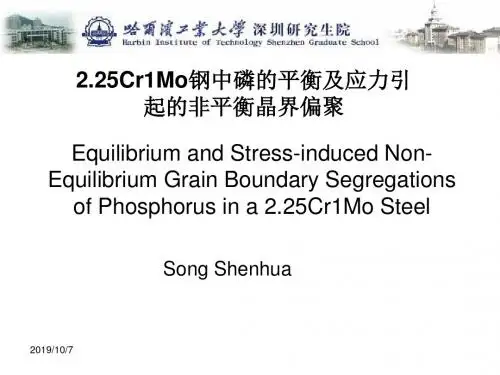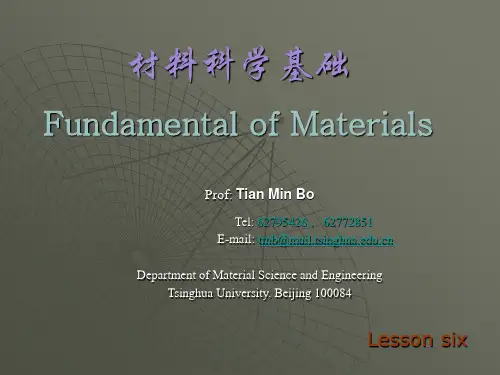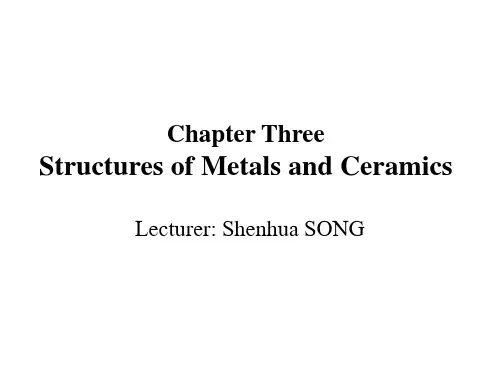- 1、下载文档前请自行甄别文档内容的完整性,平台不提供额外的编辑、内容补充、找答案等附加服务。
- 2、"仅部分预览"的文档,不可在线预览部分如存在完整性等问题,可反馈申请退款(可完整预览的文档不适用该条件!)。
- 3、如文档侵犯您的权益,请联系客服反馈,我们会尽快为您处理(人工客服工作时间:9:00-18:30)。
control the material properties (for example by altering the
grain structure, or the presence of defects in the atom
packing) or to fabricate the material into the desired shape.
extra material, joining parts (e.g., by soldering or welding),
forming (forging, rolling, bending, etc.), or compacting particles which are then fused together (sintering, used for
gases (and most engineering materials are used in solid
form).
1.1 What is Materials Science and Engineering?
It may seem abstract and remote from real engineering to
The Science and Engineering of Materials
Aim
English atmosphere: speaking, reading, writing and lisห้องสมุดไป่ตู้ening; Specialty vocabulary; Specialty knowledge;
form. As this mixture solidifies, different structures form as a function of temperature. The phase diagrams that provide
a road map to these structures are a second necessary tool
materials
1.1 What is Materials Science and Engineering?
For most of mankind's history, the available materials were few and essentially natural such as clay for bricks and pottery, wood and stone for tools and construction,
1.1 What is Materials Science and Engineering?
For many real materials, the formation of the
microstructure begins with some combination of elements
or mixing together of the proper components, often in liquid
define and limit the capabilities that the device or
structure can have, and the techniques that can be used
to fabricate it.
1.1 What is Materials Science and Engineering?
Chapter 1 - Introduction
Outline
1.1 What is Materials Science and Engineering? 1.2 Classification of Materials 1.3 Functional Classification of Materials 1.4 Classification of Materials Based on Structure 1.5 Environmental and Other Effects
1.1 What is Materials Science and Engineering?
It is common in courses such as this one to start at the
smallest scale, that of the atoms. Some familiarity with
Materials science and engineering (MSE) is an
interdisciplinary field concerned with inventing new
materials and improving previously known materials by
start at the atomic level and then gradually work up through
the ways that atoms pack together (and the important
defects in these packings) to larger dimensions, but this approach provides the necessary tools to understand and deal with the later topics.
1.6 Materials Design and Selection
Objectives
Introduce the field of materials science and
engineering (MSE)
Provide introduction to the classification of
atoms and the bonds that form between them should be
retained from chemistry courses, but perhaps not much of that has dealt with solids, as compared to liquids and
the Iron Age, and so forth.
1.1 What is Materials Science and Engineering?
Materials Science and Engineering forms the bedrock
for the engineering disciplines because the structures, components, and devices that engineers design and use must be made out of something, and that is a material. The properties of the materials that are available
1.1 What is Materials Science and Engineering?
Microstructure includes structure at dimensions ranging
from the atoms in the material and the order (or lack of it) of
their arrangement, up to the tiny grains of individual crystals
that pack together to form most solids, and even up to the nearly macroscopic level of fibers in paper, sand in concrete, and the thin, multiple layers of plastic, metal, and paper in a microwave popcorn bag.
natural fibers (either from plants or animal hair) for
cords and textiles, and skins for containers and clothing.
The ability to modify natural materials, extract useful
developing a deeper understanding of the microstructurecomposition-synthesis-processing relationships.
1.1 What is Materials Science and Engineering?
Structure means a description of the arrangements of
Anthropologists study the material artifacts of past
civilizations to understand how they were fabricated, and in
turn, to gain insight into the level of technology and sophistication of the culture. The role of materials in the advance of civilization and culture is powerfully summarized by the fact that it is the name of each dominant new material that has been used to describe the culture - the Stone Age, the Bronze Age,







